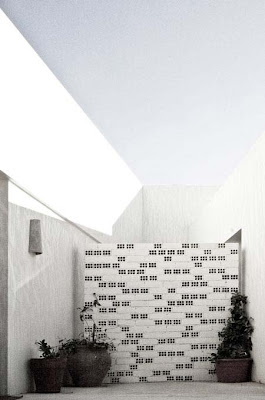By Eneseis Arquitectura

Project Type: Isolated family house
Architects: Eneseis (Daniel Solbes Ponsoda, Jose Luis Durán, Jose Vicente Lillo)
Site: Mutxamel, partida “La obrera”
Co-Architects: Katerina Zeminova Daniel Cano
Surveyor: Raquel Barceló
Builder: Abelardo Granados
Promoters: Llorenç Solbes y Virginia Mur
COst: 195.000 euros
Project date: 2006-2007
This new family residence is called Casa Llorens, located at Mutxamel, Alicante, Spain in a housing area close to the town centre, but depends on the car for transport. Designed by Spanish architects Eneseis Arquitectura, the house is partly buried and protected from being overlooked on three sides, but opens up on the fourth side to trees and views across the landscape. The house is designed to be accessible for a wheelchair user. The architects aimed to make it sustainable by optimising the amount of natural light and ventilation in each room.

This sustainable building connects the public street with a 40m narrow pass. It is surrounded on every side except the northwest, where it opens to some trees and the mountain view. The building opens towards the mountain view, and closes itself, looking for privacy, against the surrounding buildings.

SOIL AND ARCHITECTURE
Our first idea for the project came from a self-protecting instinct; the desire to build a controlled environment, our custom-made world. We modified topography to generate a trench situation, protecting the house from neighbour’s views and controlling the view out; the environment became the sky and the distant northwest landscape.
The soil that was removed from the trench was piled up on the perimeter, eliminating the usual need to take soil elsewhere. Thus, we made the relative elevation 1.5m, digging the natural soil just 0.5m. On this simplified space we adapted the architecture that completes the project. We modified 100% of the soil’s plot, generating a new reality, a synergistic union, a garden-house or house-garden, non-divisible, that chooses and generates its own accessible landscape.

SUN AND VENTILATION
We started with a linear floor distribution that begins turning, bending, raising…looking for the optimum solar place, and passive ventilation, extracting the air from the fresher places of the garden.
The sleeping-room zones remain half-buried, profiting from the temperature regulation of the thermal inertia.

MOVEMENT AND ACCESSIBILITY
We generated a continuous flow between the garden and the house, between inner and outer space. The house itself is an accessibility vehicle to the garden. When solving the accessibility problem, instead of thinking about the limitations, we preferred to think about creating an environment that could improve the abilities enjoying: resting on the water, swimming, taking sunbaths, traveling along the garden, flowing…
Inside, the spaces are dynamic, custom-fitted for a wheelchair. The movement is reinforced by the continuous white walls that build the house.